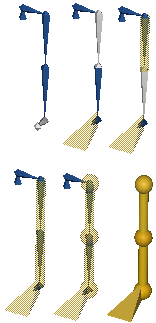| The figure editor is where you design animated characters
to put into Anim8or's scenes. The main difference between a figure and
an ordinary object is that a figure contains a bone structure, or
skeleton, that you use to bend and shape it in different poses. By setting
the pose of a character in a few key frames of an animation, you
can bring it to life. Anim8or will smoothly fill in all the in-between poses
by bending the joints of the skeleton just the right amount. You can enter
the figure editor at any time by selecting Mode->Figure in the menu. |
| The basic screen is similar to the Object Editor and is shown
below. You can also view multiple viewpoints simultaneously, as with the
other editors. |
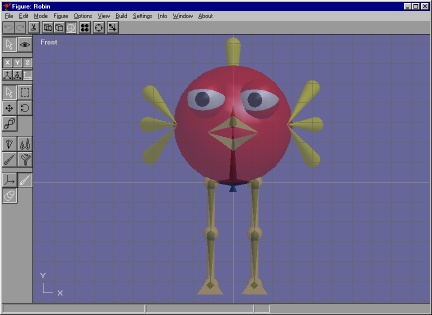
|
|
Notice the bones that are faintly visible inside of the character's body
and legs. You can control the visibility of bones, your character's body
parts, and other aspects to help with the design. This character doesn't
have any particularly interesting bones in his body, but does have animatable
legs and feet. |
| The figure editor has two modes: edit
and viewpoint. You click on one of the icons to switch between these
two modes. |
|
| Figure/Edit mode button. This is the initial mode that the
figure editor starts in. You use it to do all of your character design. |
|
| Figure/Viewpoint mode allows you to pan, scale, rotate, and
size-to-fit any or all of your views of your workspace. |
|

|
Once you have made your character's
parts, you switch into the Figure Editor and build a skeleton. Starting
at the initial root bone, you add bones one at a time to make the movable
structure of your character. For example, if you want human like legs, you
need to add a bone for each of the thigh, lower leg, and foot. You can give
each joint it's own range of motion which makes animation a lot easier. |
|
| Once the skeleton is designed you
can add the character's visible parts. You link each part to a specific
bone, and when that bone moves, so does the body part. You can also move,
scale and rotate each part individually within the coordinate space of
its bone. |
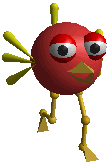
|
|
| You use the next set of buttons to
edit the bones of your character's skeleton once it has been built. |
|
| |
This mode allows you to rotate your characters joints into their
nominal position. This position defines the zero value for
all rotations that this joint can perform. It is not the same as the default
position of the joint, which is where the joint is when it's "relaxed",
but is used to define the bone's coordinate system. |
| |
You use this button to change the length of a bone. When it is pushed,
you can click on the end of a selected bone and stretch or shorten it with
the mouse. You have to be sure that you click directly on the end of the
bone or it will not change. You can also double click on a bone and set the
length directly with a dialog box. |
| |
You use this mode to add new bones to a skeleton. To add a new connecting
bone, you click on the end of a bone and drag to set the bone's length.
It will always align in the same direction of its parent. So if you want
it oriented in another direction, you must use the rotate button shown above.
|
|
Note: You have to click on the tip of the bone or nothing will happen.
If you want to attach a new bone to the end of an unselected bone, click
on the tip and it will become selected. Then click a second time
on the tip, and drag until your new bone is the right length. You can also
double click on a bone to bring up it's parameter dialog and set the length
manually. |
|
| |
This button allows you to skin part or all of a skeleton with a single
Object. Then when the joints of a bone bend the object deforms and bends
seamlessly along with the skeleton. There is more detail on how to use this
skinning tool later on. |
| You use the final group of buttons
to control what is visible in the edit window. You may find it easier to
manipulate your character's skeleton without its body getting in the way,
or want to see the final, solid look without the bones showing. These controls
will do just that. |
|
| |
You use these two buttons to toggle the visibility of
bones and body parts. If both of them are enabled then your character's
body will be shown in a sort of transparent view with the bones visible
inside. You will find this indispensable when arranging your character's
parts. If only one is enabled, the corresponding items are shown as solid
objects. |
| |

|
| |
This shows a character with a simple skeleton. Only the legs have bones,
so you could only animate the legs. The face would be frozen in that silly
look unless you added additional bones to animate the eyes, wings, beak,
etc. |
| |
This button toggles a visible axis for any selected bones. It also
shows you the range of movement for their joints. |
| Working with a lot of small bones, such
as in a hand, can create a confusing jumble of overlapping bones. You
can change the diameter use to show each bone in the Bone Editor by changing
the value in the Dia. field to help clear up the view. |

|
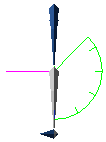
|
This is a side view of a skeleton. The show axis The bone selected here is the lower part of the right leg and forms the right knee. It can only bend in the x-axis and like a human knee can only bend backwards in this case a maximum of 135 degrees backwards. |

|
To skin an object you first attach it to a bone called its base
bone. You should pick it carefully since only the base bone's descendants
will be able to bend your object. Then enter Skinning mode by pressing the
skinning button on the toolbar |
| You can adjust the size of a bone's influence in two ways. You
can double click on it and enter numeric values, or you can edit the influence
regions directly on the screen. You can set the size if the inner and outer range for each end of the bone. You can also set the position along the bone where they start and end as a percentage of the bone's length. Changing sizes directly on the screen is often more effective but it can sometimes be tricky to do because things are often cluttered with several overlapping regions. |
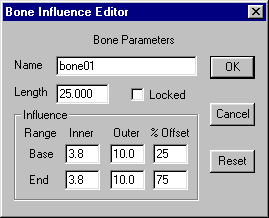
|
| There are six control points on each bone, three at each end.
If you turn off the visibility of both bones and objects by clicking on
the buttons at the bottom of the toolbar you will get a clearer picture of
what's there. You use the one at the tip of the orange area adjust the size
of the outer region, and the one at the tip of the yellow area for the inner
one. The inner yellow point adjusts the offset. |
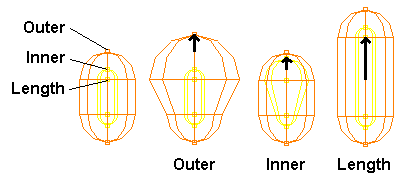
|
|
One final note: Don't attempt to adjust your bone's positions in the Figure
Editor and expect to see your mesh bend! It doesn't work that way. You will
only be adjusting the bone's position, and area of influence, relative to
your object. You must go to the Sequence editor to start animating your
character. |
|
Now you're ready to go to the Sequence Editor to make some animated sequences. Then on to the Scene Editor for your final movie! |
| This page was last updated on August
9, 2003 |
Copyright 2003
R. Steven Glanville |



